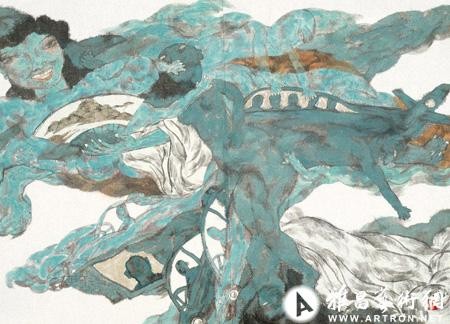
都市系列—溶变
1997年在上海举办的中国艺术大展上,郑强展出了他以都市生活为题材的水墨画作品,从他创作那件作品的时候算起,迄今已逾十年。十年来郑强一直关注着都市人的生存状态和他们的内心感受,无节制的物欲对都市人的伤害让他震惊,他看到“‘物’在疯长和膨胀。人们拥挤一起,在‘物’的洪流中沉浮。‘人’被自己制造的‘物’所挟持和吞没,在喧闹中自觉不自觉地蜕变。”(摘自画家笔记《画室自语》)用郑强的话说,这是一条匆忙流过的生命之河,他要以自己的方式画出这一条匆忙流过的生命之河,他要把当代人的生存状态和内心感受描绘成可视的图景。在他看来用自己的方式描绘当代人的内心感受是他的绘画存在的理由。
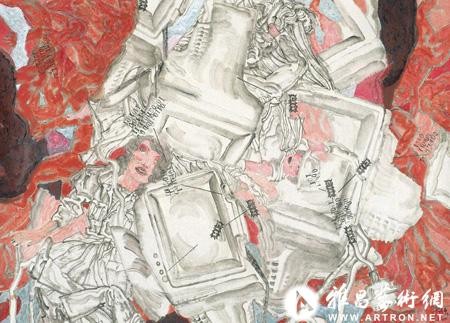
物与人——流
基于这样的创作理念,郑强自觉不自觉地运用了符号编码来建构他的都市水墨“镜像”——有如曹雪芹《红楼梦》中那有深刻人生寓意的“风月宝鉴”般的现代人生“镜像”。郑强或许仅仅只是凭借他艺术家的直觉感悟到是符号编码体现消费社会的运行机制,像鲍德里亚所认为的那样,我们进入的是一个通过符号编码而复制出来的世界,世界与符号的边界不再存在,这是一种“超真实”的世界,符号吸收现实的世界,这种吸收最后将人也变成了媒介,变成了符号——物。(参见鲍德里亚《生产之镜》,仰海峰译,中央编译出版社2005年,第8页)早在1997年在上海展出的那件作品中,郑强即已将人和物都作为符号编码同样对待,此后十年郑强的现代水墨画创作大致经历了《静观》系列(2000年)、《新编穴位图谱》系列(2003年)、近期的《人》系列(2005年)(《匆匆行走的人》、《漂浮的人》、《微笑的女人》、《宽衣的人》、《低头的人》、《回头的人》……)和《我们》系列(2006年)等几个创作阶段。在这些不同阶段的作品中画家几乎无一例外地将人和物混杂编排,各种时尚的、青春美艳的面孔和人形被形形色色的建筑物、现代交通工具和交通标志、电器和电子元件以及其它一些象征现代都市生活的符号编码所包围、裹挟。在较早的借用中国民间版画针灸图谱的《静观》系列和《新编穴位图谱》系列中,为了摒除流行水墨画中所通常使用的优美抒情和煽情格调,强调作品的精神隐喻性质和拓展水墨性绘画的观念性维度,郑强有意强化了这种独特的结构画面的手法,人和物的混杂编排尤其一目了然,因而也略显生硬。但是进入《人》系列和《我们》系列,这一象征隐喻手法的使用便不再生硬和勉强,而是显得收放自如、得心应手。尽管那些衣着时髦光鲜、充满动感与青春活力的人物形象占据了画面的构图中心位置,但人依然如物一般抽象,物也依然如人一般具体。人与物在欣赏者视觉心理中的这种相互置换,同时也是在画家精心安排的、穿插着时而如薄雾轻烟,时而如行云流水般的白色漂浮物的图象空间中完成的。这白色的漂浮物是郑强近期作品中极其耐人寻味的一个符号能指,它切割画面空间,令其似真似幻,亦真亦幻;它遮蔽或虚化人物的颜面和肢体,使其若隐若显,亦虚亦实。它是什么?说不清、道不明。但正是这一说不清、道不明的符号能指,不仅令作品的绘画性大为丰富,使画面好看,可视性增强,更令郑强的现代都市水墨“镜像”意境升华,意蕴丰富。恰如《红楼梦》中那“出自太虚元境”,“专治邪思妄动之症,有济世保生之功”的“风月宝鉴”所提示的人生哲理“色即是空,空即是色”一样,郑强的现代都市水墨“镜像”所能带给现代人的启示,不用说应该也是足以发人深省的,至此郑强已成功地将水墨性绘画的绘画性与观念性完美和谐地统一起来。
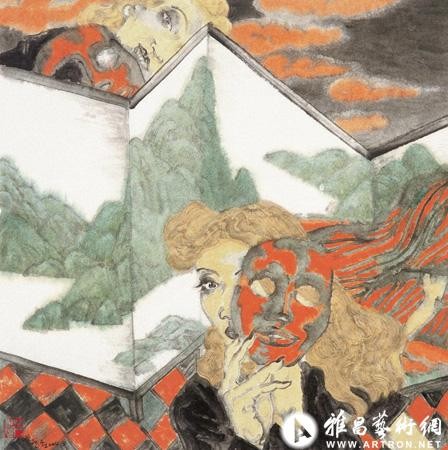
面具
郑强以十年之功磨就了他的现代都市水墨之镜。以“磨镜”来比喻郑强的现代水墨画创作历程,不只是因为郑强作品的精神隐喻性质和其对无节制的物欲与工具理性的审视批判。也因为“磨镜”是细致的手艺活,它能贴切体现十年来郑强在寻找自己独特的、包括笔墨技巧在内的水墨画艺术语言的艰难摸索中的琢磨推敲功夫和实践创新精神。笔墨问题是水墨画艺术表达中的一个至关重要的问题,中国画悠久而丰富的笔墨传统,既是现代水墨艺术创新的资源,也是它的桎梏。尽管在郑强看来独尊笔墨乃水墨画的顽疾,作为文人画笔墨基础的书法正在慢慢淡出现代社会,而当代中国水墨画的笔墨要建立在什么之上,他不知道。(见画家笔记《画室自语》)但事实却是,这十年的“磨镜”功夫,郑强将很大一部分都用在了笔墨的创新实践之上。从《静观》系列、《新编穴位图谱》系列到《人》系列和《我们》系列,郑强的笔墨技巧日渐丰富完善,也越来越个性化。如果说较早的《静观》系列和《新编穴位图谱》系列中,人和物的混杂编排一目了然,略显生硬的话,就笔墨而言也同样如此。类似“拼贴”的图象结构方法,限制了笔墨技巧的发挥,或说是观念性掩盖了水墨性。而到了近期的《人》系列和《我们》系列,郑强的现代都市水墨“镜像”则不仅意境升华,笔墨也极大地丰富起来,白色漂浮物赋予了艺术家极大的表现自由,让他有可能把淡墨和淡染色技巧发挥到极致。我们在郑强的作品中又看到了只有在关良的一些作品中才能欣赏到的那种如白银一般质地的淡墨,与关良的淡墨线条不同的是,郑强作品中的淡墨形态飘逸生动,如影随形;它们和画面中其它各种淡色的水墨晕染一起构成奇妙的乐章,形成“月笼寒水烟笼沙”一般的神秘空灵氛围。郑强作品中圆润飘逸的淡墨又与其极具写实功力且极富动感的人物造型巧妙地结合在一起,令笔墨的描写性与表现性相得益彰。淡墨和淡染色技巧独具特色的创造性发挥是郑强对现代水墨人物画的新贡献。
郑强以他的艺术实践再次证明了中国画的“笔墨无止境” !
(皮道坚 著名理论批评家 华南师大教授)
A Mirror Ground for Ten Years:
Zheng Qiang’s ‘Mirror Image’ of Metropolitan Ink Painting
Zheng Qiang exhibited one of his ink paintings created about city life at the Great Chinese Art Show in Shanghai in 1997. It has been over ten years since he created that work. During those ten years he has been keeping an eye on the living conditions and internal feelings of people in modern cities. He is shocked when ‘he sees the uncontrolled growth and expansion of materialism and the harm it has done to urban people. Crowds of people drift with the tide pursuing material desire, changing unconsciously when they are overwhelmed and swallowed by their own craving for material’ (quoted from Whisper in the Studio written by Zheng Qiang). He says, life is a rushing river, and he wants to paint the river in his own way by transforming urban people’s living situation and internal feelings into visible paintings. For him, the reason why his paintings exist is to portray people’s internal feelings in his unique way.
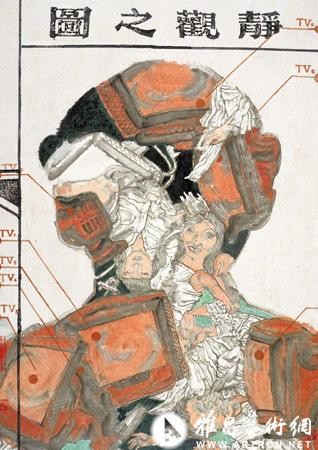
静观之图一
With such a concept of creation, Zheng Qiang uses sign coding, consciously or unconsciously, to construct his ‘mirror image’ of metropolitan ink painting – an image of modern life which has the same instructive significance as ‘the Treasure Mirror Reflecting Romantic Affairs’ in Cao Xueqin’s A Dream in Red Mansion. Maybe Zheng Qiang just senses by instinct as an artist that sign coding is the operating system of a consumer society. Just like what Baudrillard believes, the world we live in is one copied through sign coding, and there is no boundary between the world and signs. It is a ‘super real’ world; signs absorb the real world and this kind of absorption finally turns human being into a media and a sign – an object (quoted from P8 of Baudrillard’s Mirror of Production, translated by Yang Haifeng and published by Central Compilation & Translation Press in 2005). Zheng Qiang treated human being and objects as signs when he exhibited that work in Shanghai in 1997. In the following ten years his creation of modern ink painting experienced several phases, namely Watching Quietly Series (2000), Newly Edited Pressure Point Diagrams Series (2003), Man Series (2005, including Rushing Men, Floating Men, A Smiling Woman, An Undressing Woman, A Head-down Man, A Man Who is Turning Back,etc) and We Series (2006). In those works created by different phrases, he made a mixed arrangement of human figures and objects without any exceptions. Fashionable, young and beautiful figures were surrounded and swathed by various buildings, modern vehicles, traffic signs, electronics, electronic components and other signs that represent modern city life. In his earlier works like Watching Quietly Series and Newly Edited Pressure Point Diagrams Series which absorbed some elements from acupuncture, Zheng applied and intensified his style to get rid of the commonly used graceful and lyrical style in ordinary ink painting, stressing the spiritual metaphor in his works and expanding the conceptual dimension of ink painting. The mixed arrangement of figures and objects was especially obvious. However, this technique seemed a little bit awkward at that time. When he created Man Series and We Series, his employment of this metaphorical technique was not awkward any more, but became mature and proficient. Although those vigorous and fashionable figures takes the central place of the paintings, they are as abstract as the surrounding objects, and the objects are as concrete as the figures - figures and objects interchange and interact in audience’s visual psychology. Zheng achieved this interaction by creating a space in which white objects float sometimes like mist and sometimes like clouds. The white object is an interesting signifier in his recent works. It can separate the space in a painting to make it seem both unreal and real; it can shade or blur a figure’s face or body to make it visible as well as dim. What is it on earth? It is hard to explain. But this unexplainable signifier deepens the drawing characteristics of Zheng’s paintings, makes them much better and increases their visibility. More importantly, it enhances the artistic sense and enriches the implication of the ‘mirror image’ in his metropolitan ink painting. The significance of this signifier is very similar to that of the ‘Precious Mirror of Voluptuousness’ in A Dream of Red Mansion. In the novel, the mirror, which was made to heal the illnesses originateing from evil thoughts and improper designs, instructs people in philosophical thoughts such as ‘Form is emptiness and emptiness is form’. Much as, the ‘mirror image’ in Zheng’s ink paintings also brings profound instructions to people. This is the first time, Zheng had successfully harmonized the drawing characteristics and concept of ink painting.
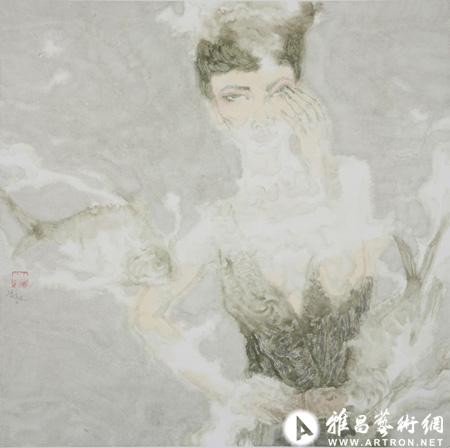
无题

雨中
Zheng Qiang has spent ten years constructing the ‘mirror image’ of his metropolitan ink painting. I would like to compare his process of creating a ‘mirror image’ to ‘grinding a mirror’, not only because of the spiritual metaphors appearing in his works but also because of the critical judgment of uncontrolled material desire. What’s more, as a delicate craft, grinding a mirror can best represent Zheng’s refinement of the work and his innovative spirit during his years’ of seeking for a unique language of ink painting. Ink and brush is a key problem in ink painting. The long and rich tradition of Chinese ink painting is a shackle as well as source of the innovation of modern ink painting. From Zheng’s view, the dominant status of ink and brush is a persistent ailment to further development of ink painting. Calligraphy as a basic technique for ink and brush has been faded out in modern China, but it still remains unknown to him on what ink and brush will build in contemporary Chinese ink painting (referred to in his Whisper in the Studio). But the fact is that, Zheng spent most of his time pursuing innovation of ink and brush. From the Watching Quietly Series, the Newly Edited Pressure Point Diagrams Series to the Man Series and the We Series, Zheng’s technique has been gradually improved and personalized. If we saw a bit awkwardness of arranging figures and objects in his earlier works, it is the same case with ink and brush. The structural method which is like paste-up does not give play to ink painting skills, in other words, the concept overshadows the drawing’s characteristics. However, his late works not only present a ‘mirror image’ with a higher level of artistic sense, but reflect great improvement in ink painting techniques. The white floating objects enable him to make full play of light ink and light dyeing technique. We see again in Zheng’s works the silver-like light ink that only can be found in some works of Guan Liang’s. But what is different from the ink lines in Guan’s works, the light ink in Zheng’s works is graceful and vivid. It interacts with other inks to compose a magic melody and create a mysterious atmosphere. The mellow and graceful light ink combines skillfully with the motive as well as realistic figures, making the descriptiveness and expressiveness of ink bring out the best of each other. The innovative use of light ink and the light dyeing method is Zheng’s new contribution to contemporary ink figure painting.
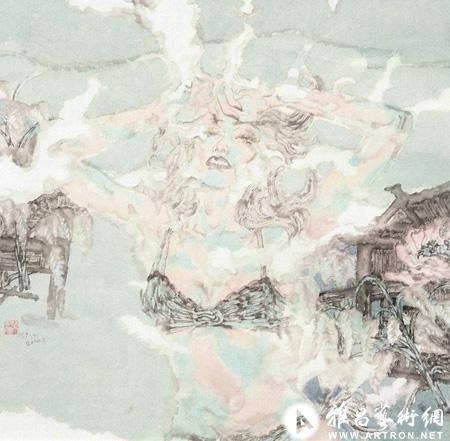
黄昏
Zheng Qiang’s art practice proves again that there is no end to exploring Chinese ink painting.
- by Pi Daojian, renowned theoretician critics, and a professor at South China Normal University
Copyright Reserved 2000-2025 雅昌艺术网 版权所有
增值电信业务经营许可证(粤)B2-20030053广播电视制作经营许可证(粤)字第717号企业法人营业执照
 京公网安备 11011302000792号粤ICP备17056390号-4信息网络传播视听节目许可证1909402号互联网域名注册证书中国互联网举报中心
京公网安备 11011302000792号粤ICP备17056390号-4信息网络传播视听节目许可证1909402号互联网域名注册证书中国互联网举报中心
网络文化经营许可证粤网文[2018]3670-1221号网络出版服务许可证(总)网出证(粤)字第021号出版物经营许可证可信网站验证服务证书2012040503023850号